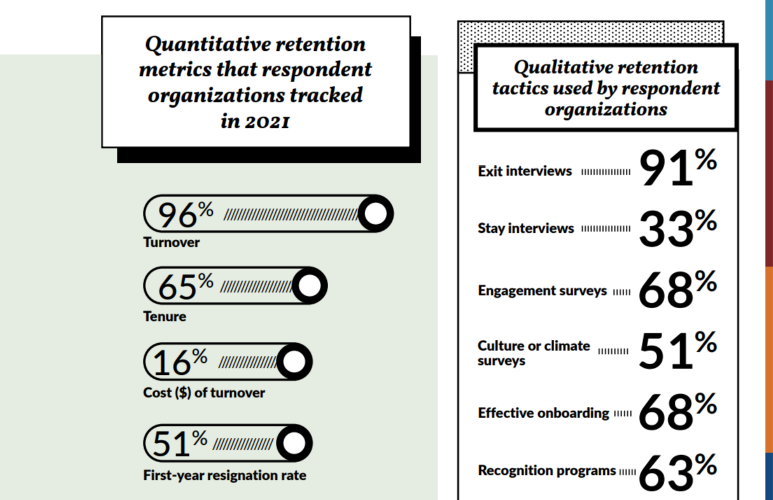The Great Resignation following the onset of COVID-19 is prompting introspection by nonprofit managers as more of them redouble efforts to retain valued employees and to recognize the importance of having a strategy for doing so.
The number of nonprofits where there is a formal employee retention strategy was found to be up 61% from the previous year, according to data from a recent survey. Additionally, 91% of respondents reported they now are conducting exit interviews and 33% said they are conducting “stay” interviews.
Moreover, 68% of respondents reported doing engagement surveys, 63% have implemented employee recognition programs, 51% said they are conducting climate and culture surveys, 25% said they now provide retention bonuses, and 21% provide long-service bonuses.
The findings were reflected in the “2022 Social Impact Talent Retention Practices Survey Results” released recently by Nonprofit HR, a human resources and talent management consultancy to the nonprofit social services sector in Washington, D.C.
Managers from more than 400 social impact organizations of varying sizes across the country participated in the survey, which Nonprofit HR conducts annually.
More than half (56%) of managers reported that COVID-19 impacted retention strategies and tactics in the form of greater flexibility regarding remote work arrangements and other accommodations, which was up from the 51% that reported the same a year earlier.
More than one-third (36%) of respondents reported that racial and social justice issues have figured into their retention strategies through adoption of diversity, equity and inclusion initiatives and related efforts, which was up from the 28% that reported the same the previous year.
Despite these efforts, decreased morale continues to be perceived by nonprofit managers as the leading negative factor exacerbating employee turnover, with the 25% of those citing this as a problem eclipsing the 23% who did so a year earlier.
A further breakdown of the results showed that employees themselves most often cited a desire for better opportunities (57%) and better compensation and benefits (46%) among their reasons for leaving voluntarily, followed by a lack of opportunity with their current organization (43%), dissatisfaction with their current organization’s culture (36%), and family needs (25%).
While longevity bonuses and loyalty programs can help increase retention, the best strategies also incorporate culture, engagement, learning and development, according to Nonprofit HR’s Tracye Weeks, D.B.A., managing director of strategy and advisory, and Heather de la Riva, managing director of outsourcing.
Adaptability in these strategies is “more of an art than a skill” with the best ones taking a holistic and multi-faceted approach, they noted.
One glimmer of hope in the report appeared to be the slightly reduced number of nonprofit managers who reported difficulty retaining Black and African American employees, which fell to 20% after checking in at 23% a year earlier.
Even this reduced figure, however, was still more than the percentage that reported for difficulty retaining employees of two or more races (14%) as well as White (12%), LatinX (5%), Asian American/Pacific Islander (3%) and Indigenous/Native American (1%) employees.
More managers also reported difficulty retaining women (36% vs. 30% a year earlier) and slightly more reported the same for men (15% vs 14% a year earlier). The percentages were negligible for transgender men (0%), transgender women (1%) and gender-variant or nonconforming individuals (1%).
The full report can be viewed on the Nonprofit HR website here.
